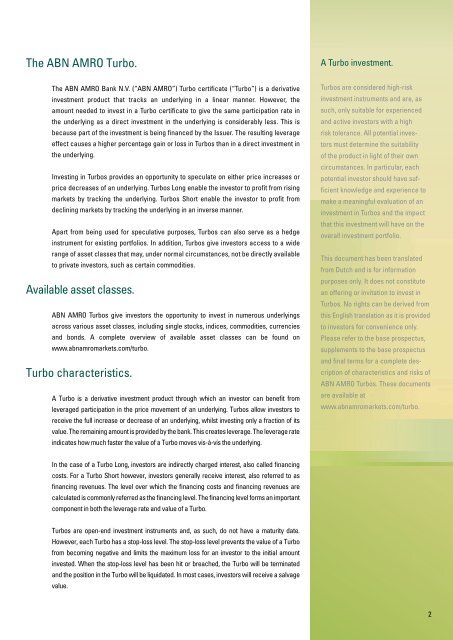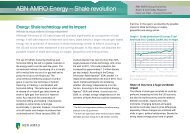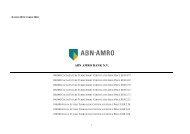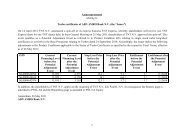ABN AMRO TURBOS - ABN AMRO Markets
ABN AMRO TURBOS - ABN AMRO Markets
ABN AMRO TURBOS - ABN AMRO Markets
Create successful ePaper yourself
Turn your PDF publications into a flip-book with our unique Google optimized e-Paper software.
The <strong>ABN</strong> <strong>AMRO</strong> Turbo.<br />
A Turbo investment.<br />
The <strong>ABN</strong> <strong>AMRO</strong> Bank N.V. (“<strong>ABN</strong> <strong>AMRO</strong>”) Turbo certificate (“Turbo”) is a derivative<br />
investment product that tracks an underlying in a linear manner. However, the<br />
amount needed to invest in a Turbo certificate to give the same participation rate in<br />
the underlying as a direct investment in the underlying is considerably less. This is<br />
because part of the investment is being financed by the Issuer. The resulting leverage<br />
effect causes a higher percentage gain or loss in Turbos than in a direct investment in<br />
the underlying.<br />
Investing in Turbos provides an opportunity to speculate on either price increases or<br />
price decreases of an underlying. Turbos Long enable the investor to profit from rising<br />
markets by tracking the underlying. Turbos Short enable the investor to profit from<br />
declining markets by tracking the underlying in an inverse manner.<br />
Apart from being used for speculative purposes, Turbos can also serve as a hedge<br />
instrument for existing portfolios. In addition, Turbos give investors access to a wide<br />
range of asset classes that may, under normal circumstances, not be directly available<br />
to private investors, such as certain commodities.<br />
Available asset classes.<br />
<strong>ABN</strong> <strong>AMRO</strong> Turbos give investors the opportunity to invest in numerous underlyings<br />
across various asset classes, including single stocks, indices, commodities, currencies<br />
and bonds. A complete overview of available asset classes can be found on<br />
www.abnamromarkets.com/turbo.<br />
Turbo characteristics.<br />
A Turbo is a derivative investment product through which an investor can benefit from<br />
leveraged participation in the price movement of an underlying. Turbos allow investors to<br />
receive the full increase or decrease of an underlying, whilst investing only a fraction of its<br />
value. The remaining amount is provided by the bank. This creates leverage. The leverage rate<br />
indicates how much faster the value of a Turbo moves vis-à-vis the underlying.<br />
Turbos are considered high-risk<br />
investment instruments and are, as<br />
such, only suitable for experienced<br />
and active investors with a high<br />
risk tolerance. All potential investors<br />
must determine the suitability<br />
of the product in light of their own<br />
circumstances. In particular, each<br />
potential investor should have sufficient<br />
knowledge and experience to<br />
make a meaningful evaluation of an<br />
investment in Turbos and the impact<br />
that this investment will have on the<br />
overall investment portfolio.<br />
This document has been translated<br />
from Dutch and is for information<br />
purposes only. It does not constitute<br />
an offering or invitation to invest in<br />
Turbos. No rights can be derived from<br />
this English translation as it is provided<br />
to investors for convenience only.<br />
Please refer to the base prospectus,<br />
supplements to the base prospectus<br />
and final terms for a complete description<br />
of characteristics and risks of<br />
<strong>ABN</strong> <strong>AMRO</strong> Turbos. These documents<br />
are available at<br />
www.abnamromarkets.com/turbo.<br />
In the case of a Turbo Long, investors are indirectly charged interest, also called financing<br />
costs. For a Turbo Short however, investors generally receive interest, also referred to as<br />
financing revenues. The level over which the financing costs and financing revenues are<br />
calculated is commonly referred as the financing level. The financing level forms an important<br />
component in both the leverage rate and value of a Turbo.<br />
Turbos are open-end investment instruments and, as such, do not have a maturity date.<br />
However, each Turbo has a stop-loss level. The stop-loss level prevents the value of a Turbo<br />
from becoming negative and limits the maximum loss for an investor to the initial amount<br />
invested. When the stop-loss level has been hit or breached, the Turbo will be terminated<br />
and the position in the Turbo will be liquidated. In most cases, investors will receive a salvage<br />
value.<br />
2






